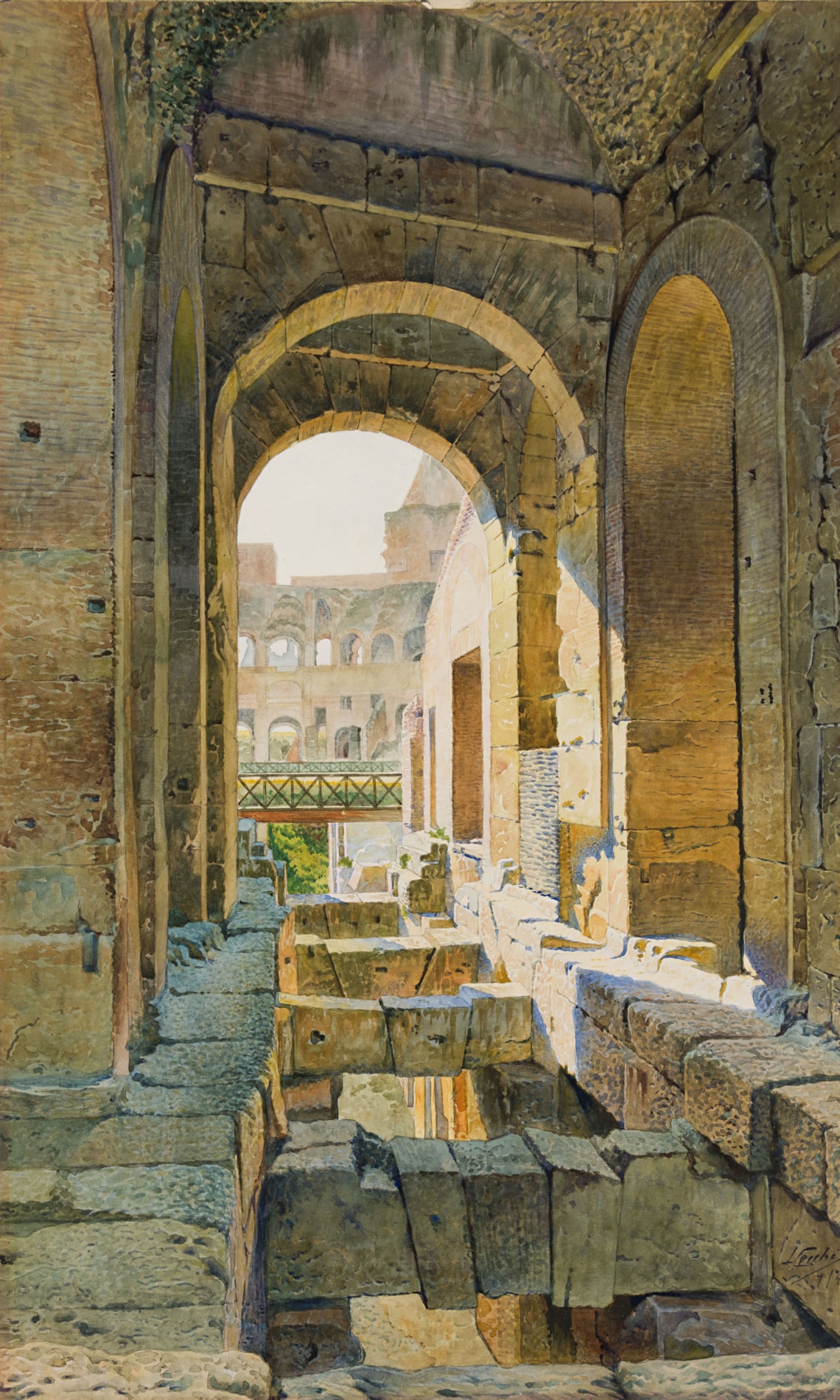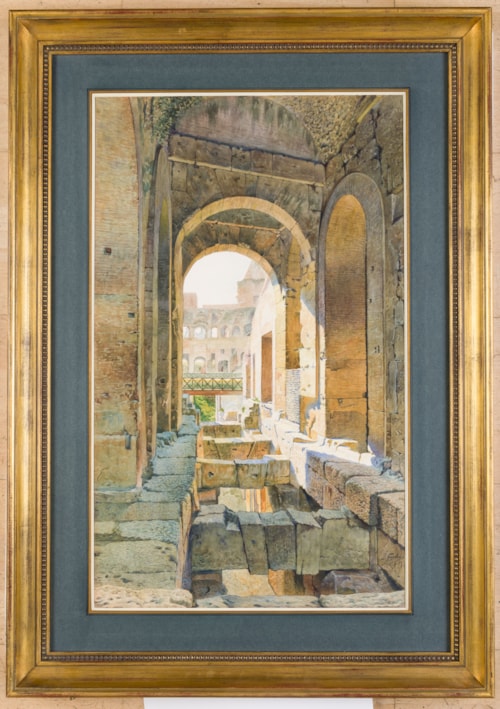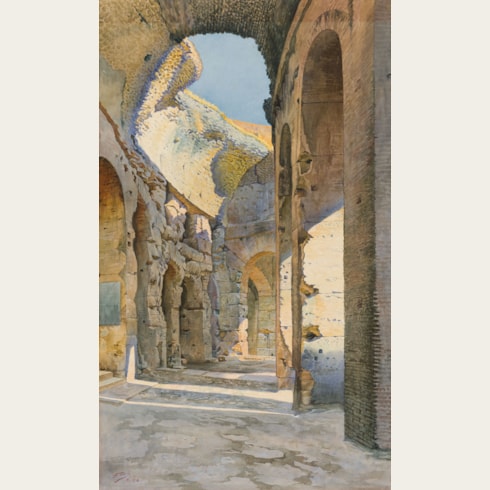Lorenzo CECCHI
(Limite sull’Arno 1864 - Ghivizzano Coreglia 1940)
A Passage in the Colosseum in Rome
Sold
Watercolour over a pencil underdrawing, with framing lines in pencil.
Signed and dated LCecchi 7 / 91- [cut off] at the lower right.
Numbered 134 on the verso.
Inscribed Regalato al / Sig. Mariolino Magnozzi / nel suo giorno di compleanno / 23. 9. 55. / Julia Lefori(?) Scarpellini on the verso.
615 x 373 mm. (24 1/4 x 14 5/8 in.)
Signed and dated LCecchi 7 / 91- [cut off] at the lower right.
Numbered 134 on the verso.
Inscribed Regalato al / Sig. Mariolino Magnozzi / nel suo giorno di compleanno / 23. 9. 55. / Julia Lefori(?) Scarpellini on the verso.
615 x 373 mm. (24 1/4 x 14 5/8 in.)
As a late 19th century guide to the ruins of Rome noted of the Colosseum, ‘Although two-thirds of the original building have disappeared under the shameful treatment to which the barbarous nobles of the middle ages subjected it, enough still remains to show the arrangement of the entrances, passages, and seats of this wonderful construction. The plan of the whole may be best described as consisting of three principal massive concentric elliptical arcades. The intervals between each of these are filled in with other arched work containing corridors and staircases, and between the innermost of these three arcades and the wall which surrounded the arena was a triple system of substruction supporting the lower parts of the rows of seats in the amphitheatre. The stone used throughout is travertine, with the exception of some interior work of brick and concrete, and some pumice-stone in the arches…The second and third of the principal concentric walls contain arches corresponding to those in the outer wall. Corridors run between these concentric walls, and on the first and second floors of the outer ring, and the first floor of the inner ring, these circles afford a completely unobstructed passage all around. The other corridors are blocked up in parts by various staircases, leading to the upper rows of seats.’
Another watercolour of the interior of the Colosseum by Lorenzo Cecchi, signed and dated 1907, was sold at auction in Italy in 2008.
Another watercolour of the interior of the Colosseum by Lorenzo Cecchi, signed and dated 1907, was sold at auction in Italy in 2008.
An architect, painter, sculptor and teacher, Lorenzo Cecchi spent his youth in the port town of Livorno, on the western coast of Tuscany. He taught at the Scuola di Arti e Mestieri, the local school of arts and crafts, for several years, and influenced a later generation of Tuscan painters. Among Cecchi’s most significant commissions as an architect is the neo-Gothic Marassi family chapel in the Cimitero delle Porte Sante in Florence; executed in the 1880s, it was one of the largest and most grandiose structures in the cemetery, but is now largely derelict. In 1908 he settled in Rome, where he worked for the next thirty years as a professor of drawing. Cecchi remains a relatively obscure figure today, even within Italy. A retrospective exhibition of his work was held in Montecatini Terme in 1972, and another show of paintings and watercolours by Cecchi was mounted at a gallery in Livorno in 2006.
Throughout his career, Cecchi was particularly admired for his finished watercolours of views, sites and monuments in the provinces of Tuscany, Sardinia, Umbria and Lazio, as well as Pompeii and the ancient temples of Magna Graecia and Sicily; all imbued with a remarkable technical virtuosity and a particular interest in architectural forms. As his biographer Gino Mazzanti, a former student, described him, he was ‘a multi-faceted and productive artist, especially in the field of architecture of which he was a profound connoisseur.’ Cecchi was perhaps best known for his vibrant watercolours of the buildings and ruins of Imperial Rome, executed during his long stay in the Eternal City.
Throughout his career, Cecchi was particularly admired for his finished watercolours of views, sites and monuments in the provinces of Tuscany, Sardinia, Umbria and Lazio, as well as Pompeii and the ancient temples of Magna Graecia and Sicily; all imbued with a remarkable technical virtuosity and a particular interest in architectural forms. As his biographer Gino Mazzanti, a former student, described him, he was ‘a multi-faceted and productive artist, especially in the field of architecture of which he was a profound connoisseur.’ Cecchi was perhaps best known for his vibrant watercolours of the buildings and ruins of Imperial Rome, executed during his long stay in the Eternal City.
Provenance
Julia Lefori(?) Scarpellini
Given by her to Mariolino Magnozzi as a birthday present in September 1955 (according to the inscription on the verso).
Given by her to Mariolino Magnozzi as a birthday present in September 1955 (according to the inscription on the verso).






